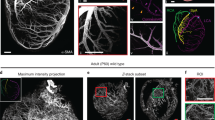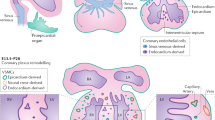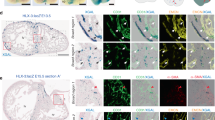Key Points
-
The coronary collateral circulation protects the heart from myocardial ischaemia, and is associated with improved survival in patients with coronary artery disease
-
Collateral vessels are present at birth, develop throughout life, undergo positive remodelling (arteriogenesis) in the presence of a total or subtotal coronary occlusion, and usually regress with age
-
The myocardial protective effect of the collateral circulation is dynamic in nature, as collateral function can be modulated by several factors
-
Preconditioning, the injection of growth factors, and measures to prolong ventricular diastolic filling time all promote collateral vessel growth and remodelling
-
Collateral flow can be reduced and even reverted if atherosclerosis progresses in the donor artery, a process called the 'collateral steal'
-
Re-establishment of the antegrade flow in the recipient artery induces a derecruitment of collaterals, thus exposing the recipient territory to myocardial ischaemia in cases of sudden coronary occlusion
Abstract
Coronary collaterals are present at birth, with wide interindividual variation in their functional capacity. These vessels protect jeopardized myocardium, and the number of collaterals and the extent of their coverage are associated with improved survival in patients with coronary heart disease. The collateral circulation is not a permanent set of structures, but undergoes dynamic changes with important consequences for cardioprotection. If a severe atherosclerotic lesion develops in an artery supplying tissue downstream of a total occlusion through collateral blood flow, pressure gradients across the collateral bed change. The result is that some of the collateral flow previously supplying the perfusion territory of the totally occluded artery is redirected to the perfusion territory of the donor artery, thus producing a 'collateral steal'. The collateral circulation can regress once antegrade flow in the main dependent artery is re-established, as occurs following the recanalization of a chronic total occlusion. The clinical benefits of coronary revascularization must be cautiously weighed against the risk of reducing the protective support derived from coronary collaterals. Consequently, pharmacological, gene-based, and cell-based therapeutic attempts have been made to enhance collateral function. Although such approaches have so far yielded no, or modest, beneficial results, the rapidly accruing data on coronary collateral circulation will hopefully lead to new effective therapeutic strategies.
This is a preview of subscription content, access via your institution
Access options
Subscribe to this journal
Receive 12 print issues and online access
$209.00 per year
only $17.42 per issue
Buy this article
- Purchase on Springer Link
- Instant access to full article PDF
Prices may be subject to local taxes which are calculated during checkout



Similar content being viewed by others
References
Helfant, R. H., Vokonas, P. S. & Gorlin, R. Functional importance of the human coronary collateral circulation. N. Engl. J. Med. 284, 1277–1281 (1971).
Wustmann, K., Zbinden, S., Windecker, S., Meier, B. & Seiler, C. Is there functional collateral flow during vascular occlusion in angiographically normal coronary arteries? Circulation 107, 2213–2220 (2003).
Epstein, S. E., Lassance-Soares, R. M., Faber, J. E. & Burnett, M. S. Effects of aging on the collateral circulation, and therapeutic implications. Circulation 125, 3211–3219 (2012).
Seiler, C., Stoller, M., Pitt, B. & Meier, P. The human coronary collateral circulation: development and clinical importance. Eur. Heart J. 34, 2674–2682 (2013).
Rogers, W. J. et al. Return of left ventricular function after reperfusion in patients with myocardial infarction: importance of subtotal stenoses or intact collaterals. Circulation 69, 338–349 (1984).
Habib, G. B. et al. Influence of coronary collateral vessels on myocardial infarct size in humans. Results of phase I thrombolysis in myocardial infarction (TIMI) trial. The TIMI Investigators. Circulation 83, 739–746 (1991).
Antoniucci, D. et al. Relation between preintervention angiographic evidence of coronary collateral circulation and clinical and angiographic outcomes after primary angioplasty or stenting for acute myocardial infarction. Am. J. Cardiol. 89, 121–125 (2002).
Zimarino, M. et al. Intraoperative ischemia and long-term events after minimally invasive coronary surgery. Ann. Thorac. Surg. 78, 135–141 (2004).
Choi, J. H. et al. Frequency of myocardial infarction and its relationship to angiographic collateral flow in territories supplied by chronically occluded coronary arteries. Circulation 127, 703–709 (2013).
Meier, P. et al. The impact of the coronary collateral circulation on mortality: a meta-analysis. Eur. Heart J. 33, 614–621 (2012).
Faber, J. E. et al. Aging causes collateral rarefaction and increased severity of ischemic injury in multiple tissues. Arterioscler. Thromb. Vasc. Biol. 31, 1748–1756 (2011).
Kurotobi, T. et al. Reduced collateral circulation to the infarct-related artery in elderly patients with acute myocardial infarction. J. Am. Coll. Cardiol. 44, 28–34 (2004).
Meier, P. et al. Beneficial effect of recruitable collaterals: a 10-year follow-up study in patients with stable coronary artery disease undergoing quantitative collateral measurements. Circulation 116, 975–983 (2007).
Conway, E. M., Collen, D. & Carmeliet, P. Molecular mechanisms of blood vessel growth. Cardiovasc. Res. 49, 507–521 (2001).
Cai, W. & Schaper, W. Mechanisms of arteriogenesis. Acta. Biochim. Biophys. Sin. (Shanghai) 40, 681–692 (2008).
Carmeliet, P. Mechanisms of angiogenesis and arteriogenesis. Nat. Med. 6, 389–395 (2000).
Schaper, W. Collateral circulation: past and present. Basic Res. Cardiol. 104, 5–21 (2009).
Ingber, D. E. & Tensegrity, I. Cell structure and hierarchical systems biology. J. Cell. Sci. 116, 1157–1173 (2003).
van Royen, N. et al. Stimulation of arteriogenesis: a new concept for the treatment of arterial occlusive disease. Cardiovasc. Res. 49, 543–553 (2001).
Heil, M. & Schaper, W. Influence of mechanical, cellular, and molecular factors on collateral artery growth (arteriogenesis). Circ. Res. 95, 449–458 (2004).
Semenza, G. L. Angiogenesis in ischemic and neoplastic disorders. Annu. Rev. Med. 54, 17–28 (2003).
Fraisl, P., Mazzone, M., Schmidt, T. & Carmeliet, P. Regulation of angiogenesis by oxygen and metabolism. Dev. Cell 16, 167–179 (2009).
Fulton, W. F. The time factor in the enlargement of anastomoses in coronary artery disease. Scott. Med. J. 9, 18–23 (1964).
Teunissen, P. F., Horrevoets, A. J. & van Royen, N. The coronary collateral circulation: genetic and environmental determinants in experimental models and humans. J. Mol. Cell. Cardiol. 52, 897–904 (2012).
Chilian, W. M. et al. Coronary collateral growth —back to the future. J. Mol. Cell. Cardiol. 52, 905–911 (2012).
Werner, G. S. et al. Collateral function in chronic total coronary occlusions is related to regional myocardial function and duration of occlusion. Circulation 104, 2784–2790 (2001).
Kinn, J. W., Altman, J. D., Chang, M. W. & Bache, R. J. Vasomotor responses of newly developed coronary collateral vessels. Am. J. Physiol. 271, H490–H497 (1996).
Brugaletta, S. et al. Endothelial and smooth muscle cells dysfunction distal to recanalized chronic total coronary occlusions and the relationship with the collateral connection grade. JACC Cardiovasc. Interv. 5, 170–178 (2012).
Murry, C. E., Jennings, R. B. & Reimer, K. A. Preconditioning with ischemia: a delay of lethal cell injury in ischemic myocardium. Circulation 74, 1124–1136 (1986).
Billinger, M. et al. Is the development of myocardial tolerance to repeated ischemia in humans due to preconditioning or to collateral recruitment? J. Am. Coll. Cardiol. 33, 1027–1035 (1999).
Werner, G. S. et al. Determinants of coronary steal in chronic total coronary occlusions donor artery, collateral, and microvascular resistance. J. Am. Coll. Cardiol. 48, 51–58 (2006).
Zimarino, M. et al. Rapid decline of collateral circulation increases susceptibility to myocardial ischemia: the trade-off of successful percutaneous recanalization of chronic total occlusions. J. Am. Coll. Cardiol. 48, 59–65 (2006).
Seiler, C., Fleisch, M. & Meier, B. Direct intracoronary evidence of collateral steal in humans. Circulation 96, 4261–4267 (1997).
Billinger, M., Fleisch, M., Eberli, F. R., Meier, B. & Seiler, C. Collateral and collateral-adjacent hyperemic vascular resistance changes and the ipsilateral coronary flow reserve. Documentation of a mechanism causing coronary steal in patients with coronary artery disease. Cardiovasc. Res. 49, 600–608 (2001).
Gould, K. L. Coronary steal. Is it clinically important? Chest 96, 227–228 (1989).
Seiler, C., Fleisch, M., Billinger, M. & Meier, B. Simultaneous intracoronary velocity- and pressure-derived assessment of adenosine-induced collateral hemodynamics in patients with one- to two-vessel coronary artery disease. J. Am. Coll. Cardiol. 34, 1985–1994 (1999).
Fujita, M. & Sasayama, S. Reappraisal of functional importance of coronary collateral circulation. Cardiology 117, 246–252 (2010).
Zimarino, M., Corazzini, A., Ricci, F., Di Nicola, M. & De Caterina, R. Late thrombosis after double versus single drug-eluting stent in the treatment of coronary bifurcations: a meta-analysis of randomized and observational studies. JACC Cardiovasc. Interv. 6, 687–695 (2013).
Meier, P. et al. Coronary collaterals and risk for restenosis after percutaneous coronary interventions: a meta-analysis. BMC Med. 10, 62 (2012).
Levine, G. N. et al. 2011 ACCF/AHA/SCAI guideline for percutaneous coronary intervention: a report of the American College of Cardiology Foundation/American Heart Association task force on practice guidelines and the Society for Cardiovascular Angiography and Interventions. Circulation 124, e574–e651 (2011).
Wijns, W. et al. Guidelines on myocardial revascularization. Eur. Heart J. 31, 2501–2555 (2010).
Epstein, S. E. et al. The late open-coronary artery hypothesis: dead, or not definitively tested? Am. J. Cardiol. 100, 1810–1814 (2007).
Tamburino, C. et al. Percutaneous recanalization of chronic total occlusions: wherein lies the body of proof? Am. Heart J. 165, 133–142 (2013).
Zimarino, M., Calafiore, A. M. & De Caterina, R. Complete myocardial revascularization: between myth and reality. Eur. Heart J. 26, 1824–1830 (2005).
Valenti, R. et al. Impact of complete revascularization with percutaneous coronary intervention on survival in patients with at least one chronic total occlusion. Eur. Heart J. 29, 2336–2342 (2008).
Meisel, S. R. et al. Relation of the systemic blood pressure to the collateral pressure distal to an infarct-related coronary artery occlusion during acute myocardial infarction. Am. J. Cardiol. 111, 319–323 (2013).
Rentrop, K. P., Cohen, M., Blanke, H. & Phillips, R. A. Changes in collateral channel filling immediately after controlled coronary artery occlusion by an angioplasty balloon in human subjects. J. Am. Coll. Cardiol. 5, 587–592 (1985).
Rockstroh, J. & Brown, B. G. Coronary collateral size, flow capacity, and growth: estimates from the angiogram in patients with obstructive coronary disease. Circulation 105, 168–173 (2002).
Seiler, C., Fleisch, M., Garachemani, A. & Meier, B. Coronary collateral quantitation in patients with coronary artery disease using intravascular flow velocity or pressure measurements. J. Am. Coll. Cardiol. 32, 1272–1279 (1998).
Traupe, T., Gloekler S., de Marchi, S. F., Werner, G. S. & Seiler, C. Assessment of the human coronary collateral circulation. Circulation 122, 1210–1220 (2010).
Vogel, R. et al. Collateral-flow measurements in humans by myocardial contrast echocardiography: validation of coronary pressure-derived collateral-flow assessment. Eur. Heart J. 27, 157–165 (2006).
Ebersberger, U. et al. Magnetic resonance myocardial perfusion imaging at 3.0 Tesla for the identification of myocardial ischaemia: comparison with coronary catheter angiography and fractional flow reserve measurements. Eur. Heart J. Cardiovasc. Imaging 14, 1174–1180 (2013).
Danad, I. et al. Hybrid imaging using quantitative H215O PET and CT-based coronary angiography for the detection of coronary artery disease. J. Nucl. Med. 54, 55–63 (2013).
Togni, M. et al. Instantaneous coronary collateral function during supine bicycle exercise. Eur. Heart J. 31, 2148–2155 (2010).
Gloekler, S. et al. Coronary collateral growth by external counterpulsation: a randomised controlled trial. Heart 96, 202–207 (2010).
Fujita, M. & Sasayama, S. Coronary collateral growth and its therapeutic application to coronary artery disease. Circ. J. 74, 1283–1289 (2010).
Lamping, K. G. et al. Bradycardia stimulates vascular growth during gradual coronary occlusion. Arterioscler. Thromb. Vasc. Biol. 25, 2122–2127 (2005).
Schirmer, S. H. et al. Heart-rate reduction by If-channel inhibition with ivabradine restores collateral artery growth in hypercholesterolemic atherosclerosis. Eur. Heart J. 33, 1223–1231 (2012).
US National Library of Medicine. ClinicalTrials.gov [online], (2013).
Meier, P. & Seiler, C. The coronary collateral circulation—clinical relevances and therapeutic options. Heart 99, 897–898 (2012).
Baffour, R. et al. Enhanced angiogenesis and growth of collaterals by in vivo administration of recombinant basic fibroblast growth factor in a rabbit model of acute lower limb ischemia: dose-response effect of basic fibroblast growth factor. J. Vasc. Surg. 16, 181–191 (1992).
Yanagisawa-Miwa, A. et al. Salvage of infarcted myocardium by angiogenic action of basic fibroblast growth factor. Science 257, 1401–1403 (1992).
Banai, S. et al. Angiogenic-induced enhancement of collateral blood flow to ischemic myocardium by vascular endothelial growth factor in dogs. Circulation 89, 2183–2189 (1994).
Unger, E. F. et al. Basic fibroblast growth factor enhances myocardial collateral flow in a canine model. Am. J. Physiol. 266, H1588–H1595 (1994).
Seiler, C. et al. Promotion of collateral growth by granulocyte-macrophage colony-stimulating factor in patients with coronary artery disease: a randomized, double-blind, placebo-controlled study. Circulation 104, 2012–2017 (2001).
Gupta, R., Tongers, J. & Losordo, D. W. Human studies of angiogenic gene therapy. Circ. Res. 105, 724–736 (2009).
Rubanyi, G. M. Mechanistic, technical, and clinical perspectives in therapeutic stimulation of coronary collateral development by angiogenic growth factors. Mol. Ther. 21, 725–738 (2013).
Lee, C. W. et al. Temporal patterns of gene expression after acute hindlimb ischemia in mice: insights into the genomic program for collateral vessel development. J. Am. Coll. Cardiol. 43, 474–482 (2004).
Jeevanantham, V. et al. Adult bone marrow cell therapy improves survival and induces long-term improvement in cardiac parameters: a systematic review and meta-analysis. Circulation 126, 551–568 (2012).
Traverse, J. H., Henry, T. D. & Moye, L. A. Is the measurement of left ventricular ejection fraction the proper end point for cell therapy trials? An analysis of the effect of bone marrow mononuclear stem cell administration on left ventricular ejection fraction after ST-segment elevation myocardial infarction when evaluated by cardiac magnetic resonance imaging. Am. Heart J. 162, 671–677 (2011).
Ziegelhoeffer, T. et al. Bone marrow-derived cells do not incorporate into the adult growing vasculature. Circ. Res. 94, 230–238 (2004).
Kaminsky, S. M. et al. Gene therapy to stimulate angiogenesis to treat diffuse coronary artery disease. Hum. Gene Ther. 24, 948–963 (2013).
Acknowledgements
During the production of this manuscript we witnessed the lost battle—fought with extreme dignity—of our beloved 32-year-old secretarial assistant Lodovica Ottavi against an incurable disease. We will always miss her.
Author information
Authors and Affiliations
Contributions
M. Zimarino wrote the article, substantially contributed to discussion of content, reviewed and edited the manuscript. M. D'Andreamatteo researched data for the article. R. Waksman substantially contributed to discussion of content. S. E. Epstein wrote the article, substantially contributed to discussion of content, and reviewed the manuscript. R. De Caterina reviewed the manuscript before submission.
Corresponding author
Ethics declarations
Competing interests
The authors declare no competing financial interests.
Rights and permissions
About this article
Cite this article
Zimarino, M., D'Andreamatteo, M., Waksman, R. et al. The dynamics of the coronary collateral circulation. Nat Rev Cardiol 11, 191–197 (2014). https://doi.org/10.1038/nrcardio.2013.207
Published:
Issue Date:
DOI: https://doi.org/10.1038/nrcardio.2013.207
This article is cited by
-
Circulating secretoneurin level reflects angiographic coronary collateralization in stable angina patients with chronic total occlusion
BMC Cardiovascular Disorders (2024)
-
Association between myocardial ischemia and plaque characteristics in chronic total occlusion
Journal of Nuclear Cardiology (2023)
-
Cytokine storm: behind the scenes of the collateral circulation after acute myocardial infarction
Inflammation Research (2022)
-
Blood flow modeling reveals improved collateral artery performance during the regenerative period in mammalian hearts
Nature Cardiovascular Research (2022)
-
Metabolic syndrome and its components reduce coronary collateralization in chronic total occlusion: An observational study
Cardiovascular Diabetology (2021)



